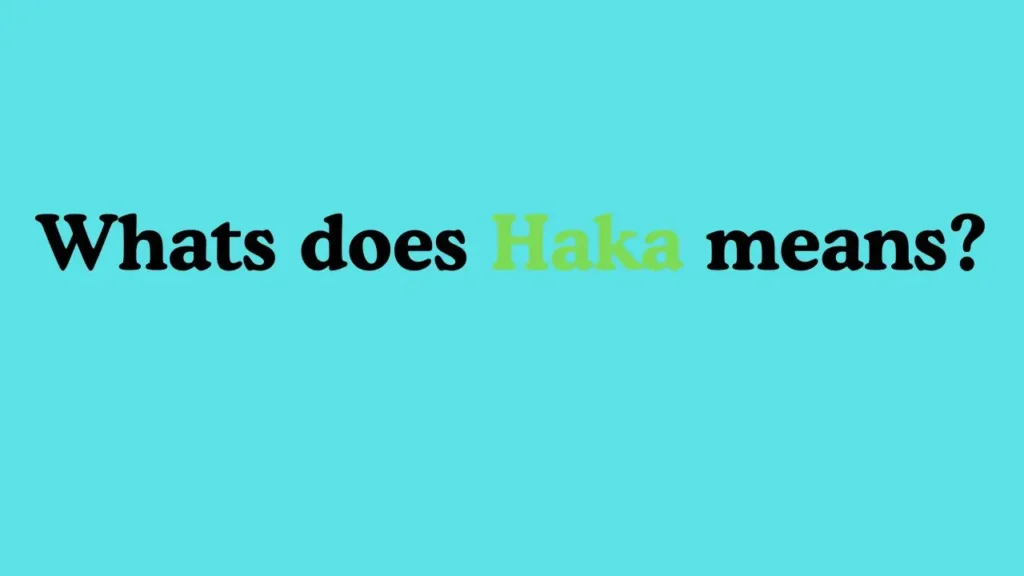Haka means
Beyond the Roar: Unveiling the Power and Meaning of Haka
The haka, a powerful display of rhythmic chanting and vigorous movements, transcends mere dance. It’s a window into the soul of Māori culture, a potent expression of identity, defiance, and unity. This article delves beyond the awe-inspiring spectacle to uncover the rich tapestry of meaning woven into every stomp, slap, and guttural cry.

Understanding the Roots:
Haka, meaning “dance” in Māori, originated as a war cry and preparation technique for battle. Warriors used it to intimidate opponents, showcase their strength and unity, and tap into their ancestral power. Today, haka performances serve a multitude of purposes, embodying:
- Welcome: Haka are performed to honor and welcome distinguished guests, expressing respect and acknowledging their significance.
- Celebration: Victories, achievements, and significant milestones are celebrated with haka, sharing joy and amplifying the collective spirit.
- Mourning: Haka can also be a poignant expression of grief, serving as a powerful way to pay tribute to the deceased and connect with the spirit world.
- Cultural Expression: Haka is a cornerstone of Māori identity, preserving traditions, showcasing language, and connecting generations through shared history and heritage.
Decoding the Symbolism:
Each haka is unique, reflecting the specific tribe, occasion, and emotions it conveys. However, some common elements weave through them all:
- Body Language: Powerful movements like stamping, slapping of chests and thighs, and wide-eyed stares symbolize strength, defiance, and unwavering resolve.
- Chants: Rhythmic chants convey stories, lineage, and ancestral connections, often invoking powerful deities and figures from Māori mythology.
- Facial Expressions: Grimaces, bulging eyes, and protruding tongues, while potentially intimidating to outsiders, represent focus, determination, and the channeling of ancestral energy.
Haka in the Modern World:
The haka has transcended its cultural boundaries, captivating audiences worldwide. Renowned sports teams like the New Zealand All Blacks have made it a pre-game tradition, inspiring awe and respect on the global stage. This cultural exchange fosters understanding and appreciation for Māori heritage, demonstrating the universality of emotions and the power of non-verbal communication.
Haka: A Living Legacy:
Haka is not a mere performance; it’s a living, breathing expression of a vibrant culture. It speaks of resilience, pride, and connection to the land and ancestors. Understanding its depths allows us to appreciate the beauty and complexity of Māori traditions, recognizing the vital role they play in shaping identity and fostering community.
Next time you witness a haka, remember, it’s more than just a spectacle. It’s a glimpse into a rich cultural tapestry, a powerful display of emotions, and a testament to the enduring spirit of the Māori people.
1. What does “Haka” actually mean?
Haka simply means “dance” in Māori language. However, it encompasses much more than just rhythmic movements, representing a powerful cultural expression.
2. What was the original purpose of the Haka?
Traditionally, haka was used as a war cry and preparation for battle. Warriors employed it to intimidate enemies, showcase their strength and unity, and tap into ancestral power.
3. How is the Haka used today?
The Haka now serves a variety of purposes beyond war preparations. It’s used to welcome guests, celebrate achievements, mourn losses, and express cultural identity.
4. What are the key elements of a Haka performance?
Body language plays a crucial role, featuring stomping, chest and thigh slaps, and intense facial expressions like wide eyes and protruding tongues. These movements symbolize strength, focus, and connection to ancestral energy.
5. Do different Haka performances have different meanings?
Absolutely! Each Haka is unique, reflecting the specific tribe, occasion, and emotions it conveys. The chants accompanying the movements often tell stories, connect to lineage, and invoke deities or figures from Māori mythology.
6. Why is the Haka performed by the New Zealand All Blacks?
The All Blacks adopted the Ka Mate Haka, originally a celebratory dance, as a pre-game ritual to showcase their unity, honor their heritage, and intimidate opponents. It has become a powerful symbol of New Zealand and Māori culture on the global stage.
7. Is the Haka considered intimidating by everyone?
While the outward display might appear aggressive to some, the true meaning of the Haka often gets misunderstood. It’s primarily about cultural expression, unity, and channeling ancestral energy, not necessarily aggression.
8. Can non-Māori people learn or perform the Haka?
Yes, anyone can learn the Haka with respect and proper understanding. However, it’s essential to approach it with humility and acknowledge its cultural significance. Learning it should be done with the guidance of those knowledgeable in Māori traditions.
9. What is the impact of the Haka on the modern world?
The Haka has transcended its cultural boundaries, captivating audiences worldwide. It fosters understanding and appreciation for Māori heritage, showcasing the power of non-verbal communication and highlighting the universality of emotions like pride, defiance, and unity.
10. Why is the Haka considered more than just a performance?
The Haka is a living expression of a vibrant culture. It’s a window into Māori identity, connecting generations through shared traditions, ancestral ties, and a deep connection to the land. Witnessing it offers a chance to appreciate the beauty and complexity of Māori heritage, understanding its role in shaping community and resilience.
Remember, the Haka is more than just a dance. It’s a powerful, multifaceted expression of a rich culture, deserving of respect and understanding.
